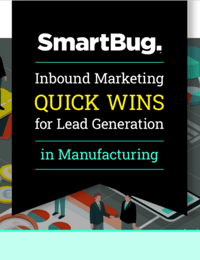
By Brad Beutler
Guest author Brad Beutler is the Director of Content at Terminus.
An account-based marketing (ABM) strategy helps B2B manufacturers with finite addressable markets take a personalized approach to targeting, engaging, acquiring, and keeping best-fit accounts. Marketers and sellers in the manufacturing world today are trying to find new ways to speed up sales cycles, engage with growing buying committees, and sustain efficient revenue growth. This blog post will show you why ABM is the perfect approach for addressing these challenges.
But before we jump into the key benefits, if you need a quick refresher or 101 lesson on the origins or philosophy of account-based marketing, check out the podcast below (jump to the 3:55 mark to get right into it).
Kula Ring Podcast Episode 63: Transform Your Business With Account-Based Marketing
Hosted by Kula Partners, an agency committed to helping leading B2B manufacturers craft digital experiences.
All right, let’s get to it. Here are four key benefits of an account-based marketing strategy for manufacturing:
1. Generate Higher-Quality Opportunities
It all starts with building a list and defining a few popular acronyms. Your ABM strategy should start by identifying your total addressable market (TAM) and ideal customer profile (ICP). Think of TAM as all of the companies you could possibly ever sell to. Then describe a company or business that’s the best fit for your product. That’s your ICP!
Need a starting point to create your own ICP? Here are a few best-customer characteristics to think about:
- Budget
- Annual revenue
- Technology or tools they already use
- Number of employees
- Geography
- Industry or vertical
How does defining your ideal customer profile help generate higher quality opportunities for your sales team? By having both sides (sales and marketing) first agree on a predefined list of best-fit accounts, you now have a priority list both teams are aligned around. It’s a priority list for the marketing team that shows them where to spend their time, resources, and money by identifying the accounts that have the best chance of becoming customers. If the list starts to become huge, use tiers to further prioritize focus. Think of the highest value future customers as your top tier; then go from there.
Once a target list is made and agreed upon, it’s time to start delivering targeted, personalized campaigns or tactics for these accounts (and the account decision makers). Will these tactics cost marketing dollars? Sure. But your marketing team will now spend more time (and money) on the accounts that matter most, and waste less time and resources on unqualified leads. With this approach, teams will spend less, increase their conversion rates, and generate higher-quality opportunities.
2. Higher Engagement with the Entire Buying Committee
What’s the best way to measure success as you start to reach out to your ICP? Engagement. Although the philosophy of account-based marketing for manufacturers might be different from that of traditional inbound marketing, the methods or tactics remain the same. This includes:
- Targeted display ads
- Retargeting
- Personalized emails
- Targeted email signature banners
- Paid social advertising
- Relevant content, events, or webinars
- Video
- Direct mail
The difference is that you’re orchestrating any or all of these tactics with a targeted list in mind, which allows you to craft each play to be hyper-personalized and targeted.
Buying committees continue to increase, and it’s especially true in manufacturing organizations that decision makers are hard to identify and pin down. Teams use account-based marketing so they can “surround” these accounts and key stakeholders, which helps the sales team get a foot in the door and better their chances of starting a conversation.
Who is easier to convince: Someone who has never interacted with your brand? Or someone who has clicked on your emails, engaged with your ads, and visited multiple pages on your website?
3. Speed Up the Sales Process
Now that you’re generating more opportunities and finding effective ways to engage with these accounts and contacts, it’s time to move them quickly through your sales cycle and convert them into happy customers.
Manufacturing deals are mostly known for two things:
- Large deal sizes
- Incredibly long sales cycles
Account-based marketing for manufacturing deals can combat point number two above and unite marketing and sales efforts to speed up the extra long sales cycle. With ABM, marketing’s involvement doesn’t end after they pass the opportunity to sales. They’re riding shotgun the whole way.
While sales does what they do best (running meetings, building relationships, and communicating the value proposition with different contacts), marketing can also stay busy. They can find new ways or channels to engage with key stakeholders and collect useful information along the way. They can also nurture accounts with retargeting ads, an email cadence, or local field events. Different campaigns can be launched to reinforce the same message the seller is communicating, all while both sides reach more decision makers and educate them on the value of your product or service.
4. Cross-Sell and Upsell Current Customers
Sales leaders are constantly enabling their team to sell new product lines, especially in the manufacturing world. This is the perfect opportunity for marketing to step in and use an ABM manufacturing strategy to support this cause.
Marketing can help identify current customers who might be a good fit for a new product (or a product that current customers aren’t using yet). They can then drive awareness and introduce the new product to these customer accounts in creative and personalized ways.
While marketing does its thing, sellers can use this accumulating account intelligence to initiate timely conversations (either to new departments or contacts they already know). This can lead to a more natural and productive dialogue between the customer and seller that doesn’t feel forced or irrelevant.
Nowadays, a simple and general press release doesn’t cut it. Personalized and creative outreach to the right customers can lead to more cross-sell and upsell opportunities for your sales team.
Conclusion
Manufacturing companies today continue to market and sell to narrow and specific audiences. Rather than waiting for these audiences to search for a term you think is relevant or to show up on your doorstep, an ABM strategy for manufacturing enables teams to proactively put your brand and message in front of key accounts and stakeholders. The best part? You’ll know exactly whom you’re targeting and be able to measure your progress every step of the way.
Whether you’re fully bought into account-based marketing, still running a lead-based strategy, or some combination of both, take advantage of the channels, tools, and data that allow you to target and reach key accounts with the right message.

About the author
Brad Beutler is the Director of Content at Terminus, where he leads all content marketing focus areas. Brad was named one of B2B Marketing Exchange’s “19 B2B Marketers to Follow” in 2019 and is a two-time winner at the Killer Content Awards. Read more articles by Brad Beutler.













